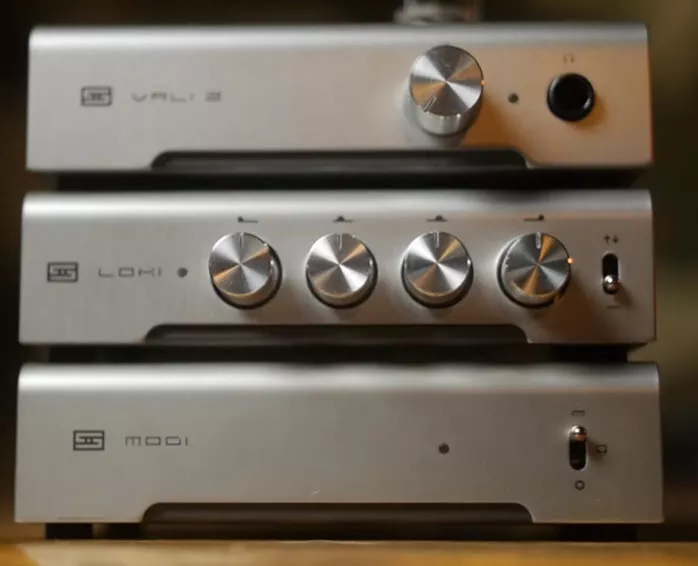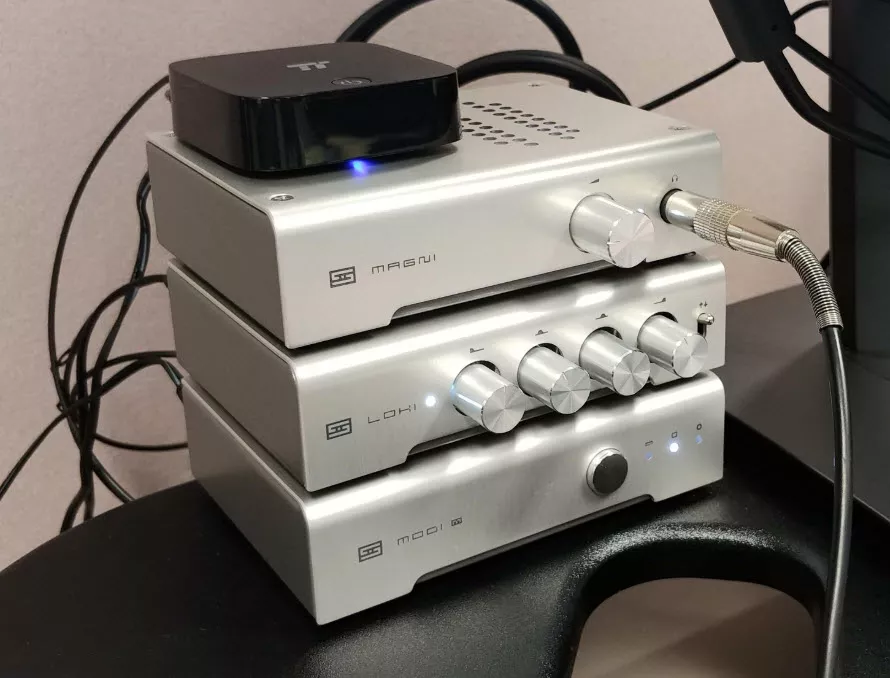Schiit Stack Review
In this article, we are reviewing the Schiit stack. We analyze the recommended configuration of three components that cover without a mandatory rack (1) cheaply and efficiently the audio flow lifecycle (5) in its entirety: digital to analog conversion (6) (7), the optional disaggregation, and compensation of ranges (10) through the equalizer, (8) (9) and the further processing in the amplifier/preamp (11) (12). All with the industry-standard cabling (2) that arranges the flow of the audio footage (4) during its processing (3).
The Schiit stack is composed, in its standard triple stack configuration, of the Schiit Modi 3 (DAC, digital-to-analog converter), Schiit Loki 4 (equalizer), and Schiit Vali 2 (tube headphone and preamp).
Let´s see what is the Schiit stack now.
The Schiit stack is a perpendicular audio landscape architecture utilized to aggregate vertically audio components in adherence to industry width and height standards. This organizational landscape physically performs a vertical consolidation of equipment in stationary or semi-mobile environments while simultaneously minimizing cable obstructions through the dynamic interrelation among the components of the rack through a standardized RCA cable network.
The components within the Schiit stack have to be connected with industry-standard RCA cables of a length of six inches or 15 centimeters RCA color code red for the right audio channel, and RCA color code white for the left channel.

This three-tier Schiit stack is the recommended configuration in terms of price and efficiency, and I will explain to you now why.
The Schiit stack is composed of the following three devices:
- Schiit Modi 3. The Digital-to-Analog (DAC) converter.
- Schiit Loki 4. Band Equalizer
- Schiit Vali 2 (tube) or Schiit Magni 3 (solid-state). Amplifier/preamp
The Schiit stack is the best stack currently in the market in relation to the price. There can be cheaper components that you can purchase, but they are not a stack, in the sense of this uniform perpendicular landscape. Likewise, there are superior audio stacks, but they cost many times more. I reviewed a dCS stack of dCS Elgar Plus + dCS Verdi + dCS Purcell in this article: it was much better than the Schiit stack, but costs about 32K.
Back in the day, people used to have stereo racks and they used to have a special cabinet that you would put everything in and you would have your tape deck on the bottom, you’d have your receiver, equalizer, maybe turntable on the top, and so this kind of reminds me of that setup except miniaturized for your desk and this is why we call it a stack.

ONE OF THE TWO PERFECT SCHIIT STACK CONFIGURATIONS. THE DAC (MODI); THE EQUALIZER (LOKI) AND THE SOLID STATE AMPLIFiER PREAMP MAGNI (INSTEAD OF THE VALI THAT IS TUBE)
Audio Flow Within The Schiit Stack
Let´s study the process lifecycle of the audio flow within the Schiit stack.
So first in the flow, we have the Schiit Modi 3 connected via USB directly to the computer or to the device that is the source of the audio footage.
Then, the second step, is that the digital to analog conversion takes place in the Schiit Modi 3 DAC and it outputs analog to the Schiit Loki 4. The Loki 4 is the equalizer, and it is performing the compensation of frequency ranges and the wave disaggregation according to your requirements. This is the “equalization”.
From the Schiit Loki 4, it goes to the Schiit Vali 2 (tube) or the Schiit Magni 3 via a red RCA 6 inches cable. These are both headphone amplifiers and that is useful if you want to connect headphones. This is more than enough power to drive headphones. Apart from driving the headphones, it also acts as a preamp, which is recommended if the user listens on loudspeakers rather than headphones.
We have a Modi 3 on the bottom and that’s a DAC digital-analog converter. Then above that, we the Loki and it is an equalizer, and I know a lot of people don’t “believe” in equalizers, but I do and later I will explain to you why.
Then finally, we have the Vali – and this is a tube headphone amplifier/preamp. So I’m actually using it with both functions on my desk, but that goes on you as you prefer it.
Let´s see all the components of the Schiit stack in more detail.
Schiit Modi 3: The DAC
Starting with the DAC, I must admit that I can’t really hear too much difference between the DACs. I know that there are charts published by manufacturers where they depict differences in performance, waveform analysis. However, with the Schiit Modi 3 you will notice an improvement
I notice of course a difference in some other DACs too: The Realtek in your computer is not as good as the internal DAC of the Devialet Gold or Silver Phantom and is not like the dCS Elgar Plus that however costs 4K.
This DAC Schiit Modi 3 costs $99, which is pretty low considering what it does. The build quality and the fact that it is designed and built here in the US, are two points in favor. Allow me a short excursus in saying that we have also reviewed here European brands, from which I bought my Devialet speaker and Japanese brands too.
Now, we said 99 dollars. This is cheap compared to many DACs, but also consider that the one that comes with your computer is free. I have a Lenovo ThinkPad that comes with a Realtek DAC, so I need an external DAC.
The Modi III plugs in directly into your computer via USB. If you need more power, it actually has another port available, in case your computer doesn’t output sufficient power.
You also have the option of using the optical in and what will happen is whether you bring in the audio from the optical or from the USB it’s going to output the audio in analog form via the RCA in the back. Therefore, if I decided not to use the Schiit Modi 3 (the DAC), then I’d be outputting directly from my computer and I’d use a 3.5 millimeter to RCA cable. If for example, let’s say that the headphone jack on my computer does not work, then I really don’t have that option on my laptop.
There is a switch in the front that will allow you to switch between the USB and the optical. So as curious as to whether I could hear a difference between the Schiit Modi 3 and another DAC that I have tested, the SMSL SK10
Thus, I had the rest of the Schitt stack hooked up exactly the same, except that I switched out the Schiit Modi 3 replacing it for the SK 10, and the first thing that I noticed is that I was hearing “clipping”.
So I was playing music and so I started adjusting the volume down in the SK10 until I have noticed a point where it was not producing a digital clipping. The reason was that I had the volume too loud in the SK10 and that was producing the clipping effect.
It is something to consider that with the Modi 3 there is no volume control on here, so there’s nothing to really worry about. It is matched up perfectly with the rest of the components. Therefore, it is just one less thing to worry about.
So we should spend more always in the DACs? Initially, if I needed to improve my sound,if it was between using my computer speakers or spending $100 on a DAC versus a hundred bucks on some actually powered speakers regardless of what type they are, I think that the powered speakers would give you more benefit in the short term.
But as the DAC is the first step in the process, if you want to sanitize your audition flow lifecycle you have to start by a good digital-to-analog converter and the Schiit Modi 3 is the place to start for a Schiit stack configuration.
Schiit Loki 4 Band Equalizer

SWITCH THE LOKI EQUALIZER ACCORDING TO YOUR REQUIREMENTS.
Let’s move up to the second gear in the Schiit stack, and this is the Schiit Loki 4 Band Equalizer. It is a 4 band equalizer. I know that about half of the readers of this website are against equalizers. I am in favor of equalizers, and I will tell you why.
The equalizer will compensate for the frequency ranges of the audio signals through the utilization of filters that enable a positive gain (boost) or a negative gain (cut). It equalizes or compensates for different tonal side effects and places them in synchronization.
Hence, having equalization means you can boost the high frequencies. If you say as one of the readers in the comments “I am bass player and I want to learn a bassline off a recording”, you may attenuate the highs, and bring up the bass frequencies disaggregating them from the rest of the audio footage. If you’re a singer, instead, depending on your vocal range (for example, contralto) you can boost any given vocal performance to make it easier to hear vocal harmonies, vocals are generally mid-range, meaning having your EQ set flat.
Recordings are all different. Therefore, through adequate filtering, we can enable compensation in the frequency ranges through the utilization of the equalizer in accordance to our requirements. Some recordings may be top-heavy (treble) some bottom-heavy (bass), and the list goes on. Having EQ as the Schiit Loki 4 gives you a certain amount of control over how you hear any given recording.
The first knob here is for the lower bass frequencies. The second knob is for the midbass: so let’s say, somebody who has a voice with a low register, this setting will affect that.
Then you have your upper mids which is the higher end of the vocal range. The last one is for the upper treble. Tweak the controls of the Schiit Loki 4 according to your preferences.
The reason I like using an equalizer, such as the Schiit Loki 4, is that speakers are just inherently not perfect but even more so, speakers act differently in different locations. Some speakers do not have too much vertical or horizontal dispersion, and you cannot position yourself in another chair or location in the room. An example of a ProAc Response DT8 does not have much vertical dispersion.
I would be able to pull the sound out of the speakers without the equalizers, yes. However, this is something that I wanted to have. You can perfectly have a Schiit stack without the equalizer and only two devices and it is fine like that too.
I have my speaker’s the Tekton, and the Devialet and they’re very close to the wall because that’s where I have to put them. If I could bring them forward. Back against the wall, it enhances the bass a little bit too much so I can turn that down if I want to.
I can make these minor adjustments to my personal tastes and I don’t see anything wrong with that.
I think equalizers are awesome I think everybody should have an equalizer. If you are a musician, it is mandatory to have an equalizer to disaggregate the different components of a piece of audio footage. If you have a Schiit stack, your equalizer must be the Schiit Loki 4
Schiit Magni 3 or Schiit Vali 2: Headphone Amplifier or Preamp
Let´s go now to the amplifiers. Here you have to devices that are practically identical: the Schiit Magni 3 or the Schiit Vali 2. The first is “solid-state” and the second one is “tube”.
I also have a tube. Well, I love the way the tube sounds. I feel like it rounds up the structure of the sound. It is less accurate than solid-state, but I am fine here with this option.
Tube amps are generally more expensive in initial cost and to operate (because you need to replace the tubes occasionally), and solid–state amps are generally less delicate and more reliable. Many players, however, feel that tube amps yield a warmer, more musical tone and more musical-sounding.
So which are your options for this third gear in the Schitt stack: Let´s see:
if you prefer solid-state (which a lot of you seem to prefer), then you do have the option of getting the Schiit Magni 3, which is basically the same gear as the Schitt Vali 2, but solid-state and without the tube. The price on the Schiit Vali 2 is 149 dollars (plus the eventual replacement of the tubes) and the price on the Schiit Magni is 50 dollars only.
RCA Cables Required For The Schiit Stack
The stack does not come with the right cables. These components bring cables in a proprietary format PYST. I recommend you to buy RCA cables with a length of six inches (15 centimeters). They bend well behind the devices and you do not see them while you are using the Schiit stack.
The components within the Schiit stack have to be connected with industry-standard RCA cables of a length of six inches or 15 centimeters RCA color code red for the right audio channel, and RCA color code white for the left channel
Are There Any Cons?
I wish that the switch turn on and off each of the devices was in the front because I always have to reach back behind in order to turn that off for both the equalizer (Schiit Loki 4) and the headphone amplifier /preamp (Vali or Magni). The DAC I always keep it on.
I wish it was just an easier way such as a switch in the front.
Conclusions
So all these components of the stack, are not things that you “need”, they are things that improve your life, so to say.
You can use the DAC of your computer, that in some cases it is a weak embedded Realtek. You do not need an equalizer, as you can simply output the music directly to your speakers or headphones without compensating the frequency ranges. But I really notice a difference if I bypass the utilization of the equalizer, so yes, I want to have it.
Regarding the last of the devices in the stack, the Vali I do not need a tube preamp – do I need a headphone amplifier? here the answer would be no I wouldn’t need that I could just plug it in my headphone jack. The Vali (tube) or the Magni (solid-state) would only add more potency.
Further Readings
We have some other interesting articles for you to read, we have selected our top articles below, and tried to keep this list short.
We have a technical vademecum where we discuss industry terminology and how it can be useful for you. Selected examples are the definition of PCM audio, then comes the comparison between PCM and Bitstream, the comparison between DTS Neo 2.5 and Dolby Digital, and the process to match amplifiers to speakers.
Also, we have reviewed some interesting DAC: The Elgar Plus from dCS, and the Schiit stack. where the Modi 3 behaves as an entry-level DAC.
In our reviews of AV receivers, we can recommend you to read some of our favorites, the ones that we liked the most, and trying to make the list short, we have the Denon AVR-X2500H, the Onkyo TX-NR686. We also have reviewed completely the Denon 8K receivers where we have studied the 8K Denon AVR-X2700H, the Denon AVC-X6700H, the AVC-X4700H, and the AVC-X3700H.
If you are into amplifiers, my favorite is the McIntosh MA9000, and that is why I would like to recommend you to read that review. My second favorite amplifier is the Mark Levinson 5805.
Regarding speakers, we have reviewed tiny bookshelf-speaker devices to large towers. My favorites were: the Devialet Gold, the Devialet Silver, the ProAc Response DT8, the Bowers and Wilkins 805 D3,
We do not review many headphones, but if you want a Sennheiser headphone for less than 100 dollars, we have this Sennheiser HD595 review.
We have some TV and monitor reviews and here we recommend the Samsung NU8000 (for gamers!) and my favorite is the review of the classical Pioneer Kuro.
Our home theater aficionados want to know everything about video definitions and configurations. So we studied 720p, how to scale it to 1080p the right way, and compared 1080p with 1440p and demonstrated why 1440p is not always better. Likewise, we had the urge to compare 1440k with 4K and try to find out how much are we gaining with the change.

I am Bob. I work as an audio engineer and audio technician. I work in mastering and arranging bridges in existing songs and the arrangement and orchestration of the chorus. In Planet HiFi I test gear for a couple of days and write a review. I also write about AV topics, amplifiers, speakers, and headphones.
